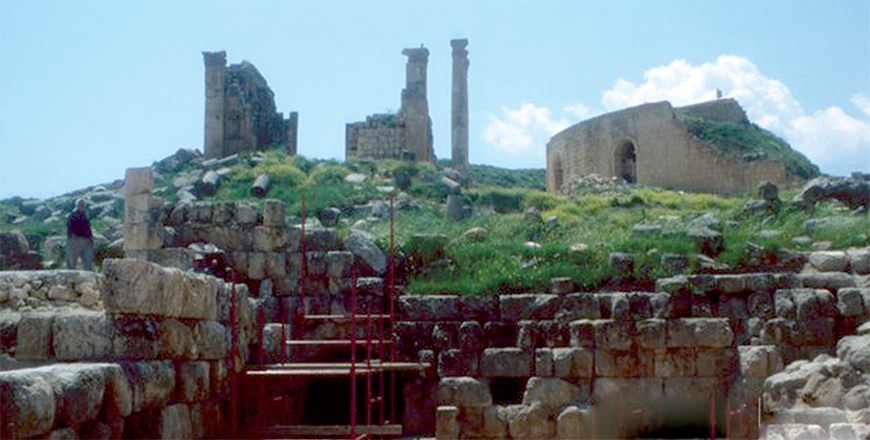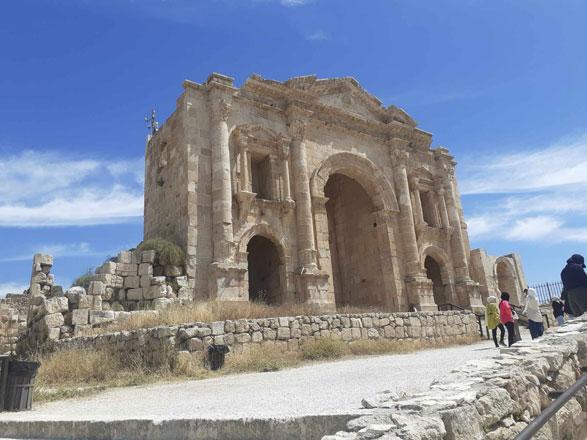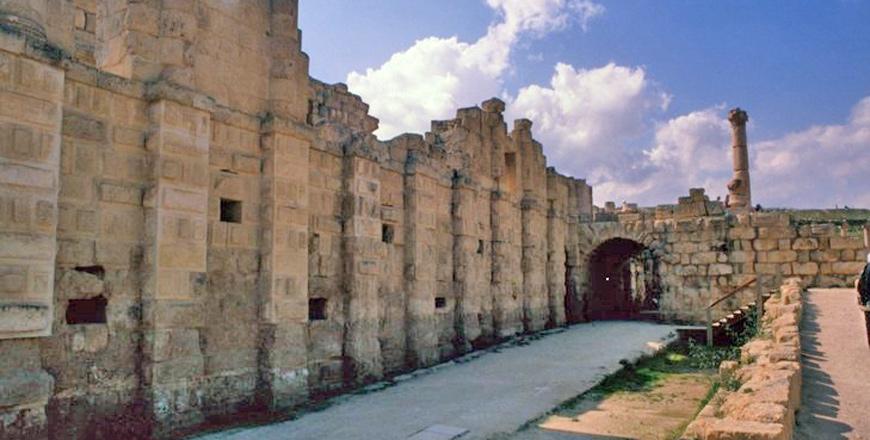You are here
Unveiling Roman urbanism: Theories of Gerasa
By Saeb Rawashdeh - Feb 03,2024 - Last updated at Feb 03,2024

The remains of the Temple of Zeus in Gerasa, modern-day Jerash (Photo courtesy of ACOR)
“It appears that the first quarries were the Late Hellenistic, at least on the South-West and probably also in the central area,” noted Australian scholar Ina Kehrberg-Ostrasz, adding that the work was abandoned in the third decade of the 2nd century AD.
This can be seen as additional support in the argument that urban planning and “closures” went well ahead of the actual construction of the second century monuments, and reinforces the argument that implementation of building programmes was gradual.
“In the 1st century AD, architectural remains still standing in situ provide information about the building phases in urban planning programmes,” Kehrberg-Ostrasz said, adding that the best preserved ruins are the South Theatre, the lower terrace and the vault of the Sanctuary of Zeus. Other monuments are either known through inscriptions or their foundations under second century structures like those of the North and South Gates.
“Spolia [stones taken from an old structure and repurposed for new construction] of a small round temple tomb, built in the 1st century BC/AD and destroyed in the early 2nd century AD, was found in the core of the Hadrianic Arch and can be traced back to this monumental tomb just north of the arch,” the archaeologist said, adding that the city walls excavations at the west wall revealed an earlier foundation incorporated in the foundation wall of the city wall securely dated to the early 2nd century AD. Ashy lenses and burnt offerings could be dated by the pottery assemblage and fragments of building décor to the 1st century BC/AD.
“The painted stucco was identical to the Late Hellenistic blocks found in the naos at the Zeus Sanctuary both in style and material,” Kehrberg-Ostrasz emphasised, noting that the nature of the finds and the stratified contexts makes it highly likely that the incorporated foundation and assemblage belonged to a contemporary naos or temple tomb at this spot which had to make way for urban development, in this case the city wall, just like the other contemporary temple tomb outside the city wall opposite Hadrian’s Arch and the hippodrome.
The population of Gerasa during different times can also be of some help to researchers. However, the evidence of the size of the population in the 1st century BC of Gerasa is difficult to reach.
“Estimated seating in the South Theatre is around 3,000 people, counting the seat stones, but that number is far below even a mean average. Here also, kiln dumps [representing only a fraction of production] and the tombs still in operation could add valuable information about the growth of population as well as urban spread or limits in the 1st century BC,” Kehrberg-Ostrasz elaborated.
The hypothesis that Gerasa grew from one central nucleus in the south and gradually spread to the north of the city was presented on the basis that the Sanctuary of Zeus was the first and most important, and that was claimed by a French archaeologist, Jacques Seigna.
“From this generally adopted view derived the idea that architectural blocks of the 1st centuries BC and AD reused as spolia at other sites belonged to this southern cult centre, or vice versa, that the idea was formed by Late Hellenistic spolia found in other buildings in the north,” Kehrberg-Ostrasz underlined.
However, this theory that the Zeus Sanctuary was the nucleus of the city has to be re-evaluated and checked.
“Once one accepts the possibility that the north was also populated in the 1st century, there is a little reason to assume that the 2nd century population transported spolia as building material from the south to the north of the city,” she outlined, adding that it appears reasonable to propose instead that the Gerasene builder quarried for ready-made blocks close at hand.
The latter is reinforced by three known 1st and early 2nd century AD temples in the northern ‘district’.
“These are the first Artemis temple known from inscriptions, the foundation remains of Temple C, and the concealed remains of a third temple dated to the end of that century or beginning of the second, the so-called Dionysus temple under the Cathedral. Three temples in the northern half alone, spreading over the 1st century AD and into the early 2nd century AD, and not forgetting that these shrines, even if for funerary cults, must have represented a well-established community, bespeak of simultaneous urban planning in the north and south,” Kehrberg-Ostrasz underscored.
Related Articles
AMMAN — In the 1st century BC and 1st century AD, Gerasa (modern Jerash) had operational quarries, which are types of open-pit mines used fo
AMMAN — Scholars were unsure about the exact foundation date of the four-kilometre-long city wall in Jerash (ancient Gerasa), noted an Austr
AMMAN — Ancient Gerasa (modern Jerash) was a well-known centre for pottery production: The evidence for that large scale commerce comes from














